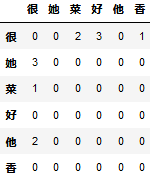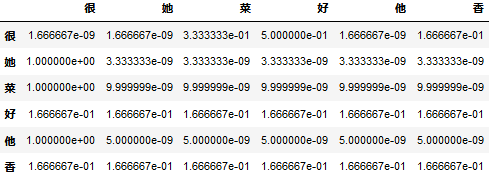版权声明:本文为博主原创文章,遵循 CC 4.0 BY-SA 版权协议,转载请附上原文出处链接和本声明。
文章目录
原理简述
统计语言模型(Statistical Language Model),可用于计算一个句子的合理程度。
表示句子,由有序的
个词
组成,句子概率
的计算公式如下:
N-gram
unigram
bigram
Add-k Smoothing
k=1;bigram;C表示count
e.g.
我很帅
她很美
代码&步骤
from collections import Counter
import numpy as np
"""语料"""
corpus = '''她的菜很好 她的菜很香 她的他很好 他的菜很香 他的她很好
很香的菜 很好的她 很菜的他 她的好 菜的香 他的菜 她很好 他很菜 菜很好'''.split()
"""语料预处理"""
counter = Counter() # 词频统计
for sentence in corpus:
for word in sentence:
counter[word] += 1
counter = counter.most_common()
lec = len(counter)
word2id = {counter[i][0]: i for i in range(lec)}
id2word = {i: w for w, i in word2id.items()}
"""N-gram建模训练"""
unigram = np.array([i[1] for i in counter]) / sum(i[1] for i in counter)
bigram = np.zeros((lec, lec)) + 1e-8
for sentence in corpus:
sentence = [word2id[w] for w in sentence]
for i in range(1, len(sentence)):
bigram[[sentence[i - 1]], [sentence[i]]] += 1
for i in range(lec):
bigram[i] /= bigram[i].sum()
"""句子概率"""
def prob(sentence):
s = [word2id[w] for w in sentence]
les = len(s)
if les < 1:
return 0
p = unigram[s[0]]
if les < 2:
return p
for i in range(1, les):
p *= bigram[s[i - 1], s[i]]
return p
print('很好的菜', prob('很好的菜'))
print('菜很好的', prob('菜很好的'))
print('菜好的很', prob('菜好的很'))
"""排列组合"""
def permutation_and_combination(ls_ori, ls_all=None):
ls_all = ls_all or [[]]
le = len(ls_ori)
if le == 1:
ls_all[-1].append(ls_ori[0])
ls_all.append(ls_all[-1][: -2])
return ls_all
for i in range(le):
ls, lsi = ls_ori[:i] + ls_ori[i + 1:], ls_ori[i]
ls_all[-1].append(lsi)
ls_all = permutation_and_combination(ls, ls_all)
if ls_all[-1]:
ls_all[-1].pop()
else:
ls_all.pop()
return ls_all
print('123排列组合', permutation_and_combination([1, 2, 3]))
"""给定词组,返回最大概率组合的句子"""
def max_prob(words):
pc = permutation_and_combination(words) # 生成排列组合
p, w = max((prob(s), s) for s in pc)
return p, ''.join(w)
print(*max_prob(list('香很的菜')))
print(*max_prob(list('好很的他菜')))
print(*max_prob(list('好很的的她菜')))
1、工具导入
from collections import Counter
import numpy as np, pandas as pd
pdf = lambda data, index=None, columns=None: pd.DataFrame(data, index, columns)
pandas用于可视化(Jupyter下),亦可用matplotlib、seaborn等工具
2、语料预处理
corpus = '她很香 她很菜 她很好 他很菜 他很好 菜很好'.split()
counter = Counter() # 词频统计
for sentence in corpus:
for word in sentence:
counter[word] += 1
counter = counter.most_common()
words = [wc[0] for wc in counter] # 词库(用于可视化)
lec = len(counter)
word2id = {counter[i][0]: i for i in range(lec)}
id2word = {i: w for w, i in word2id.items()}
pdf(counter, None, ['word', 'freq'])

3、unigram
unigram = np.array([i[1] for i in counter]) / sum(i[1] for i in counter)
pdf(unigram.reshape(1, lec), ['概率'], words)

4、bigram
bigram = np.zeros((lec, lec)) + 1e-8 # 平滑
for sentence in corpus:
sentence = [word2id[w] for w in sentence]
for i in range(1, len(sentence)):
bigram[[sentence[i - 1]], [sentence[i]]] += 1
# 频数
pd.DataFrame(bigram, words, words, int)

# 频数 --> 概率
for i in range(lec):
bigram[i] /= bigram[i].sum()
pdf(bigram, words, words)

5、概率计算
def prob(sentence):
s = [word2id[w] for w in sentence]
les = len(s)
if les < 1:
return 0
p = unigram[s[0]]
if les < 2:
return p
for i in range(1, les):
p *= bigram[s[i - 1], s[i]]
return p
print(prob('菜很香'), 1 / 6 / 6)
基于Bigram的文本生成
https://github.com/AryeYellow/NLP/blob/master/TextGeneration/tg_trigram_and_cnn.ipynb
from collections import Counter
from random import choice
from jieba import lcut
# 语料读取、分词
with open('corpus.txt', encoding='utf-8') as f:
corpus = [lcut(line) for line in f.read().strip().split()]
# 词频统计
counter = Counter(word for words in corpus for word in words)
# N-gram建模训练
bigram = {w: Counter() for w in counter.keys()}
for words in corpus:
for i in range(1, len(words)):
bigram[words[i - 1]][words[i]] += 1
for k, v in bigram.items():
total2 = sum(v.values())
v = {w: c / total2 for w, c in v.items()}
bigram[k] = v
# 文本生成
n = 5 # 开放度
while True:
first = input('首字:').strip()
if first not in counter:
first = choice(list(counter))
next_words = sorted(bigram[first], key=lambda w: bigram[first][w])[:n]
next_word = choice(next_words) if next_words else ''
sentence = first + next_word
while bigram[next_word]:
next_word = choice(sorted(bigram[next_word], key=lambda w: bigram[next_word][w])[:n])
sentence += next_word
print(sentence)
附录
| en | cn |
|---|---|
| grammar | 语法 |
| unique | 唯一的 |
| binary | 二元的 |
| permutation | 排列 |
| combination | 组合 |
统计语言模型应用于词性标注,Python算法实现